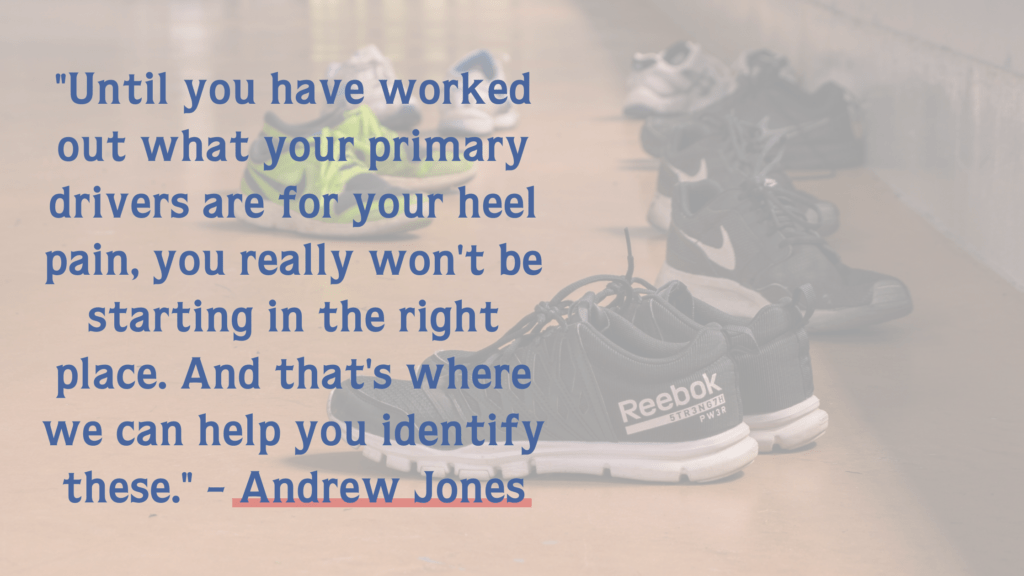Understanding and Treating Heel Pain: Insights from Andrew Jones at Waikato Podiatry Clinic
 Heel pain can be a debilitating issue that affects your daily life and mobility. At Waikato Podiatry Clinic, we focus on identifying the root causes of your heel pain, which we refer to as “drivers.” Understanding these drivers is crucial for effective treatment and long-term relief. It is important to understand that the “drivers” will vary for most people and that is why a standardised approach often falls short.
Heel pain can be a debilitating issue that affects your daily life and mobility. At Waikato Podiatry Clinic, we focus on identifying the root causes of your heel pain, which we refer to as “drivers.” Understanding these drivers is crucial for effective treatment and long-term relief. It is important to understand that the “drivers” will vary for most people and that is why a standardised approach often falls short.
In this blog, we’ll explore some common causes of heel pain and how we can help you address them.
Identifying the Drivers of Heel Pain
The first step in treating heel pain is to pinpoint the specific causes or “drivers.” Here are some common drivers that might be contributing to your discomfort:
- Tight Calves
- Impact: Tight calf muscles can lead to increased tension on your heel.
- Solution: Regular calf stretches can alleviate this tension. Visit our website for detailed instructions on effective calf stretches.
- Loading Issues
- Impact: Compressive loads (squashing, weight-bearing) and tensile loads (pulling from the fascia) on the heel can cause pain.
- Solution: Proper footwear and orthotics can help distribute the load more evenly.

- Trauma
- Impact: Sudden impacts, such as jumping or landing heavily, can trigger heel pain.
- Solution: Rest and supportive footwear can aid recovery.
- Footwear Choices
- Impact: Wearing the wrong type of shoes or sudden changes in footwear can exacerbate heel pain.
- Solution: Ensure your shoes provide adequate support and cushioning.
- Gait Style and Foot Type
- Impact: Changes in gait due to your foot shape or alignment, and injuries or surgeries (like hip or knee replacements) can lead to heel pain.
- Solution: A gait analysis can identify necessary adjustments to reduce stress on the heel.
- Chronic Stress and Occupational Load
- Impact: Prolonged standing or walking can contribute to heel pain.
- Solution: Incorporate breaks, use cushioned mats, and wear supportive shoes.
- Training Errors
- Impact: Improper training techniques or overtraining, especially in runners and athletes, can lead to heel pain.
- Solution: Adjust training routines and ensure proper warm-up and cool-down exercises.

- Anatomical and Medical Conditions
- Impact: Conditions like rheumatoid arthritis or systemic inflammatory diseases can predispose individuals to heel pain.
- Solution: Medical management of underlying conditions along with targeted treatments for heel pain.
Comprehensive Treatment Options
At Waikato Podiatry Clinic, we offer a variety of treatments to address heel pain effectively:
- Orthotics: Custom orthotics can provide the necessary support and alignment for your feet.
- Footwear Advice: We can recommend appropriate footwear that supports your specific needs.
- Taping: This can help reduce strain on the plantar fascia.
- Cortisone Injections: These can provide temporary relief from inflammation.
- PRP Injections: Platelet-rich plasma therapy can promote healing in chronic cases.
- Identification of tightness and weakness to implement the correct stretch and strength programme for your needs.
Take Action: Self-Care and Professional Help
While you can start by doing calf stretches and ensuring your footwear is appropriate, professional assessment and treatment are essential for long-term relief. Identifying your primary drivers is key to effective treatment.
As Andrew Jones from Waikato Podiatry Clinic says:

We’d love to hear from you to see if we can help with your heel pain, and work with you to create a route to becoming pain-free. Contact us here.
